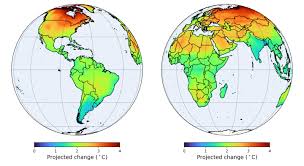
As we navigate through the challenges of 2025, climate change remains one of the most pressing issues facing humanity. The impacts of global warming are intensifying, affecting ecosystems, economies, and communities worldwide. Scientists predict that the next decade will be critical in determining the future trajectory of climate change, and a series of emerging trends in environmental science, policy, and public awareness point to a future where addressing climate change is more urgent than ever.
The Intensifying Climate Crisis
By 2025, the effects of climate change are expected to be even more pronounced. Unprecedented heatwaves, wildfires, and extreme weather events are already becoming more frequent and severe. In places like California, Australia, and parts of southern Europe, wildfires have become a regular occurrence, fueled by rising temperatures and droughts. With global temperatures surpassing 1.5°C above pre-industrial levels, these phenomena are likely to worsen. According to experts, this trajectory could lead to catastrophic outcomes for vulnerable ecosystems and millions of people living in coastal or low-lying areas.
Sea levels are also rising faster than anticipated, threatening major cities around the world. The melting of polar ice caps, combined with the expansion of warmer ocean waters, is causing unprecedented flooding events. In 2025, major cities like New York, Miami, and Shanghai will have to adopt more aggressive strategies for flood control and mitigation to protect their infrastructure and populations.
Technology and Innovation in Climate Solutions
While the challenges posed by climate change seem daunting, innovative solutions are emerging. Advances in renewable energy technologies are offering hope for a cleaner future. By 2025, solar and wind energy are expected to account for a significantly higher share of the global energy mix. Innovations in battery storage, grid infrastructure, and energy efficiency will further support the transition to renewable energy sources.
Carbon capture and storage (CCS) technology is also evolving, with large-scale projects in the pipeline. These systems are designed to capture CO2 emissions from power plants and industrial processes and store them underground. While still in the early stages, if scaled effectively, CCS could play a key role in reducing the amount of carbon dioxide in the atmosphere, mitigating the effects of climate change.
Another promising development is the rapid growth of sustainable agriculture. By 2025, regenerative farming techniques, which focus on improving soil health, enhancing biodiversity, and sequestering carbon, will likely become more widespread. These practices not only mitigate climate change but also help improve food security by creating more resilient agricultural systems.
International Cooperation and Policy Shifts
The global community’s response to climate change is crucial in shaping the future of the planet. The Paris Agreement, signed in 2015, set ambitious targets for reducing greenhouse gas emissions. However, many experts argue that countries need to do more to meet those targets. By 2025, there is a growing sense of urgency, with governments around the world under pressure to implement stronger climate policies.
One key development in climate policy is the rise of carbon pricing mechanisms. Several countries, including the European Union, are expanding carbon taxes and emissions trading systems to incentivize industries to reduce their carbon footprints. In the U.S., there is increasing support for a national carbon tax, though it remains a contentious political issue. The success of these policies will play a significant role in shaping the future of global emissions.
The Role of Individuals and Communities
In addition to government action and technological innovation, individuals and communities will continue to play a crucial role in addressing climate change. The growing awareness of environmental issues among the public has led to more sustainable choices in everyday life. Electric vehicles (EVs) are becoming more affordable and widespread, and sustainable fashion and plant-based diets are gaining popularity as consumers seek to reduce their environmental impact.
By 2025, we can expect more cities and communities to adopt green infrastructure, such as urban forests, green roofs, and community gardens. These initiatives not only help mitigate climate change by absorbing CO2 but also improve public health and quality of life. Furthermore, environmental education will be integrated into school curriculums worldwide, empowering future generations to be more climate-conscious.
The Road Ahead: A Crossroads for Humanity
As we look toward the future of climate change in 2025 and beyond, the path we choose will determine the fate of the planet. If governments, businesses, and individuals take bold action now, we can still mitigate the worst effects of climate change. However, failure to act swiftly and decisively could lead to irreversible damage to our ecosystems and way of life.
The fight against climate change is a global challenge that requires cooperation, innovation, and a commitment to sustainability. In the coming years, we will see a shift toward a more resilient and sustainable world, with a focus on reducing emissions, transitioning to clean energy, and adapting to the changes already set in motion.
Ultimately, the future of the planet depends on the choices we make today. The next decade is critical in determining whether we can curb climate change and create a future where people and the planet can thrive together.